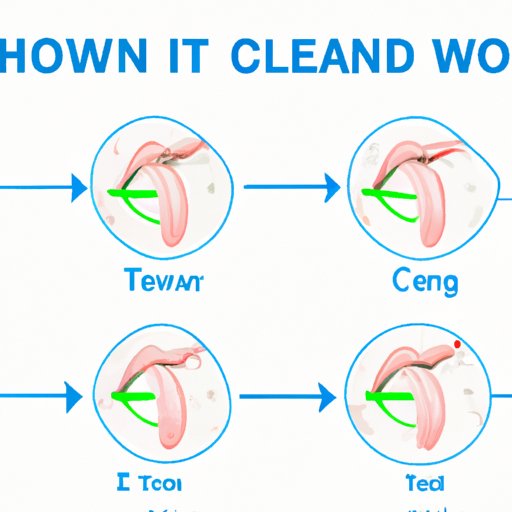
Introduction
Do you ever wake up with morning breath that just won’t go away? Or do you find yourself constantly popping breath mints throughout the day to mask a less-than-pleasant odor emanating from your mouth? If so, you may need to pay closer attention to your tongue – one of the most overlooked areas when it comes to oral hygiene.
While brushing your teeth and flossing are important aspects of oral care, neglecting your tongue can lead to the build-up of bacteria and debris, resulting in bad breath and other health issues. Keep reading to learn more about the importance of cleaning your tongue and how to do it properly.
5 Easy Steps to a Clean and Healthy Tongue
The process of cleaning your tongue is relatively straightforward and can be completed in just a few easy steps. Here’s how to get started:
1. Gather necessary materials
Before you begin cleaning your tongue, you’ll need a tongue scraper or a soft-bristled toothbrush. You can purchase a specialized tongue scraper from your local drugstore, or use a toothbrush with soft bristles if you prefer.
2. Prepare the tongue scraper or brush
If you’re using a tongue scraper, make sure to rinse it off with warm water before use. If you’re using a soft-bristled toothbrush, wet it with warm water before cleaning your tongue.
3. Clean the tongue from back to front
Extend your tongue out of your mouth and gently scrape or brush from the back of the tongue towards the front. Be sure to apply gentle pressure to avoid bruising or injuring the tongue.
4. Rinse mouth with water
After cleaning your tongue, rinse your mouth with warm water to remove any residue or bacteria that may have been dislodged.
5. Repeat process daily
Make cleaning your tongue a daily habit to ensure optimal oral health and fresh breath.
Say Goodbye to Bad Breath: Ultimate Guide to Tongue Cleaning
If you’re dealing with persistent bad breath, your uncleaned tongue may be to blame. In fact, the majority of the bacteria that cause bad breath reside on the tongue. In addition to using a tongue scraper or brush, there are a few other tips to keep in mind when it comes to effectively cleaning your tongue and preventing bad breath:
- Avoid smoking and using tobacco products, which can contribute to bad breath
- Drink plenty of water throughout the day to keep your mouth moist and reduce bacteria build-up
- Chew sugar-free gum or suck on sugar-free candies to stimulate saliva production
- Consider using an antibacterial mouthwash to kill any remaining bacteria in your mouth
- If bad breath persists, consult with your dentist or physician to rule out any potential underlying health issues
The Importance of Cleaning Your Tongue and How to Do It Correctly
Have you ever looked closely at your tongue and noticed a white or yellowish film covering it? That’s bacteria, plaque, and dead cells that have accumulated on the surface of your tongue. Not only can this lead to bad breath, but it can also contribute to other oral health issues such as tooth decay and gum disease.
Cleaning your tongue regularly has a number of important health benefits, including:
- Reduces bad breath and improves overall mouth odor
- Enhances your sense of taste by removing bacteria that interfere with taste buds
- Helps prevent tooth decay and gum disease by removing bacteria from around the teeth and gums
- Stimulates saliva production, which helps to neutralize acid in the mouth and reduce plaque buildup
In addition to using tongue scrapers or brushes, there are other tools available for tongue cleaning, such as tongue cleaners with bristles or electric tongue cleaners. Ultimately, the tool you select will depend on your personal preference and oral care needs.
Tongue Cleaning: Simple Daily Practice for a Fresher Mouth
Now that you know the importance of cleaning your tongue and how to do it properly, it’s time to make it a daily habit. Fortunately, incorporating tongue cleaning into your daily routine is simple and straightforward. Here are a few ideas to get you started:
- Make tongue cleaning part of your morning or evening oral care routine
- Keep a tongue scraper or brush at your desk or in your car for quick touch-ups throughout the day
- Pair tongue cleaning with other healthy habits, such as drinking water or stretching in the morning
Remember to replace your tongue scraper or brush regularly, as worn tools may be less effective at removing bacteria and debris.
Natural Ways to Clean Your Tongue and Keep It Free from Bacteria
If you prefer to use natural remedies for oral care, there are a few options available for tongue cleaning:
- Baking soda: Mix a small amount of baking soda with water to create a paste, then apply to your tongue and scrub gently with a soft-bristled toothbrush.
- Oil pulling: Swish coconut oil or another oil around in your mouth for several minutes before spitting it out. This can help to remove bacteria and reduce bad breath.
- Turmeric: Mix turmeric powder with water to create a paste, then apply to your tongue and scrub gently.
While these natural remedies can be effective for some people, it’s important to remember that they are not a substitute for regular dental care. Consult with your dentist or physician if you have any concerns about your oral health.
Conclusion
As you can see, cleaning your tongue is a simple and important step in maintaining optimal oral health and reducing bad breath. By following the steps outlined in this guide, you can ensure that your tongue stays clean and free from harmful bacteria. So why not make tongue cleaning a part of your daily routine today?
Don’t forget to try out different tongue cleaning methods to find the best fit for your needs, and replace your scraper or brush regularly to ensure maximum effectiveness.




